From war to famine: How the conflict in Ukraine is pushing countries into a deadly hunger crisis
In September 1921, Save the Children responded with a cargo of 600 tons of aid to support children living in famine in parts of Russia. Over the next two years, daily meals provided by Save the Children helped more than 300,000 children survive. Now, 101 years later, Save the Children is fearful as millions of people worldwide are at risk of famine due to a combination of factors—climate, conflict and COVID-19—exacerbated by the Ukraine crisis.
How can a conflict like this push so many nations further into a hunger crisis? Russia and Ukraine together produce nearly one-third of the world’s wheat, a staple for many countries across the globe. In just 10 days the war pushed the price of grain up by 21%. Combine this with extreme drought, crop failure, COVID-19 and economic system collapses, and today 800 million people in the world are chronically hungry.
This is not just a humanitarian crisis; it is the biggest challenge of our time and we must respond accordingly for the sake of humanity. Recently Canada announced $73 million in funding towards ending the escalating hunger crisis putting so many children at risk in the Horn of Africa.
Now, Canada must inspire as well as encourage other global leaders to push for a plan to address the hunger crisis before it is too late.
“We are grateful for Canada’s response to this crisis and we call on other governments to follow Canada’s initiative in reaching children and communities in dire need of life-saving interventions. The scale of this crisis is unprecedented—never in modern history have so many lives been at risk from hunger,” said Patrick Robitaille, Head of Humanitarian Affairs for Save the Children Canada.
What is happening and where:
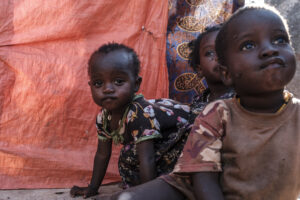
East and Southern Africa—One of the worst droughts in a generation is currently unfolding in the Horn of Africa. In Somalia alone, around 1.4 million children face Severe Acute Malnutrition. When Salma (pictured on the left) was only 20 months old she became very ill. She had a hard time breathing and was referred to a Save the Children Stabilization Centre where she was treated for Severe Acute Malnutrition.
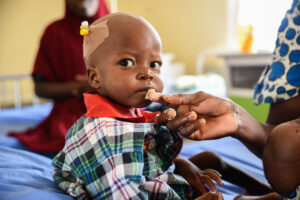
West and Central Africa—West Africa is facing its worst food crisis in a decade, with 27 million people at risk of going hungry. Musa* was 18 months old when he was admitted to the stabilization centre in Maiduguri, northeastern Nigeria. He was very sick and received treatment for severe malnutrition. The children who are admitted to the stabilization centre stay for 14 days with their mothers for treatment and recovery before they are discharged.
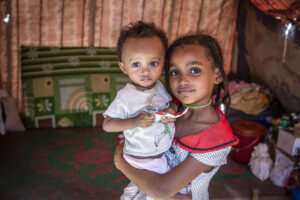 Middle East— Import-dependant countries like Yemen have been severely affected by the war in Ukraine, which only adds to the existing strain on their resources and access to food. There was an 81% price increase to food baskets, which is hard for many families to afford. Fifteen-month-old Noura* and his sister lived in a displacement camp in Hodeidah, Yemen, after fleeing violence. In the camp Noura was able to receive treatment for Severe Acute Malnutrition.
Middle East— Import-dependant countries like Yemen have been severely affected by the war in Ukraine, which only adds to the existing strain on their resources and access to food. There was an 81% price increase to food baskets, which is hard for many families to afford. Fifteen-month-old Noura* and his sister lived in a displacement camp in Hodeidah, Yemen, after fleeing violence. In the camp Noura was able to receive treatment for Severe Acute Malnutrition.
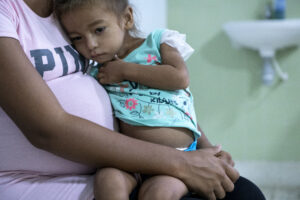 Latin America and Caribbean—Food insecurity affects 41% of the population in Latin America. According to the Regional Panorama of Food and Nutrition Security 2021, hunger in Latin America and the Caribbean is at its highest point since 2000.
Latin America and Caribbean—Food insecurity affects 41% of the population in Latin America. According to the Regional Panorama of Food and Nutrition Security 2021, hunger in Latin America and the Caribbean is at its highest point since 2000.
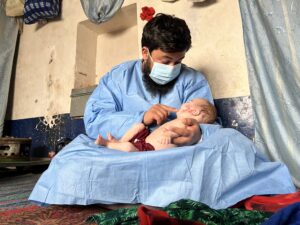
Asia—Afghanistan’s lingering food crisis has worsened and close to 23 million people are expected to be food insecure by the end of May 2022. Dr. Sadat* works as Team Leader of Save the Children’s mobile health clinic in Jawzjan, Afghanistan, and travels to remote areas providing necessary healthcare to children. He assesses and treats children like nine-month-old Firesh* for malnutrition.
Save the Children’s response to the hunger crisis:
Training and Engagement
In order to increase quality of care, Save the Children provides training for community healthcare workers to manage and treat acute malnutrition. In addition, we engage with key decision-makers, including community leaders and caregivers, to improve feeding practices of infants and young children.
WASH – Water and Sanitation
Lack of access to water for sanitation and hygiene is linked to acute malnutrition. Save the Children rehabilitates water points within health facilities and communities. We also provide gender-responsive sanitation facilities and health and hygiene kits to households.
Protection
Conflict often limits access to basic services like healthcare and can exacerbate populations’ vulnerability to acute malnutrition. Save the Children supplies and equips health facilities with necessities to provide adequate and immediate care to those in need.
As the horrific war in Ukraine continues, a global reaction is needed to respond to the extreme suffering that is also occurring in other parts of the world. Before the war started in Ukraine, the United Nations’ Food and Agriculture Organization estimated that 161 million people in 42 countries were in extreme food insecurity. This means they were in urgent need of food assistance. This number of people at risk is the most extreme since the early 2000s. The war in Ukraine has created consequences that sadly will worsen the existing global hunger crisis.
We encourage our supporters to help us address the growing hunger crisis that is putting millions of children at risk.
To support Save the Children’s response to the hunger crisis please click here.
Sources:


